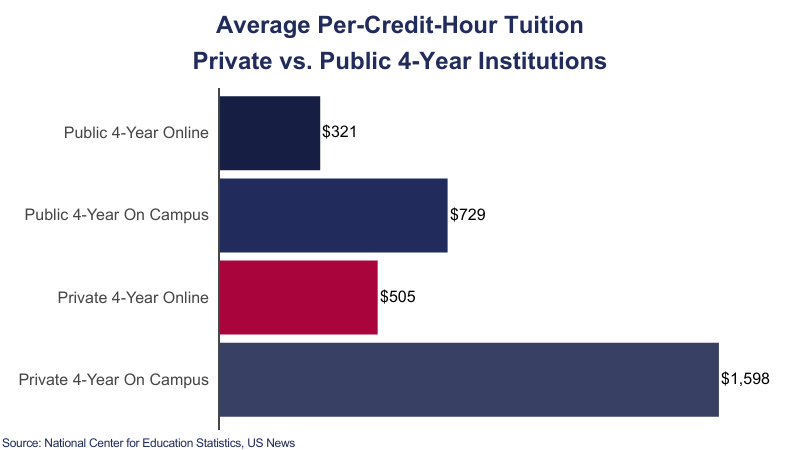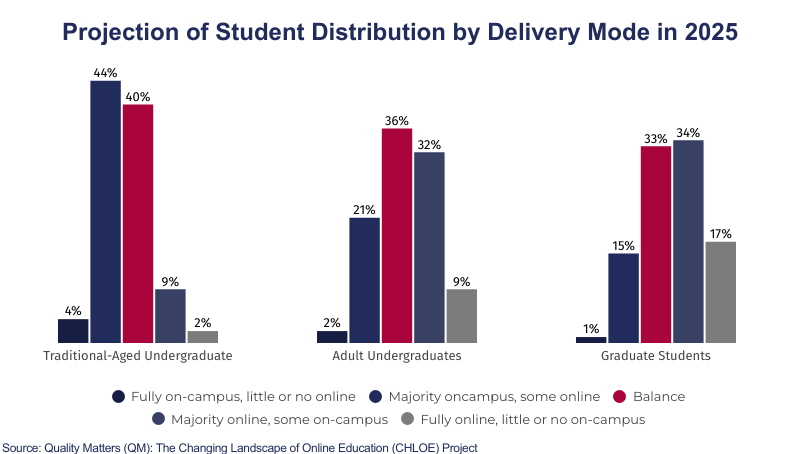Report Highlights. For public 4 year colleges, when tuition and the cost of attendance are compared between an online degree and an out-of-state traditional degree, the online degree is $30,545 cheaper.
- Private institutions on average charge $62,756 for an online degree vs $198,616 for an in-person degree.
- Students who commute to college for in-person classes pay on average, a minimum of $1,290 per year in transportation costs, which an online student wouldn’t have to pay.
- Students who attend in-person classes that utilize campus meal plans pay $2,670 dollars more for meals than if they were to make them at home for the whole year.
- The in-state cost of an online degree based on tuition from a public university is roughly $40,926 vs $39,000 for the same degree, in-person.
Related reports include | Average Cost of Private School | Cost of a College Class or Credit Hour | Average Cost of College Textbooks | Average Cost of College by State | Average Cost of College & Tuition
Cost Per Credit Hour of In-Person Instruction vs. Online Instruction
Generally, private schools don’t mark up their programs as highly as public schools do, but the overall cost of attendance is higher to attend a private institution compared to a public one. While the average per-credit-hour rate is overall higher, private institutions generally charge less for online instruction than in-person instruction. Private institutions also offer fewer online programs.
- The average, in-state tuition rate for in-person instruction in the US among 4-yr public schools for the 2022-23 academic year was $325.00 per credit.
- The average, in-state tuition rate for online instruction in the US among public schools for the 2023-24 academic year was $341.05 per credit.
- The average, in-state tuition rate for in-person instruction in the US among private 4-year schools for the 2022-23 academic year was $1,175.00 per credit.
- The average, in-state tuition rate for online instruction in the US among private schools for the 2023-24 academic year was $516.00 per credit.

Cost of Attendance between Online Instruction vs. In-Person Instruction
The true cost of an in-person degree comes from the various expenses families take in when moving their students from one environment to another. Several of these costs do not show up in online instruction because the student is already situated in an established home environment. Many of the advantages on-campus students enjoy, such as enhanced financial aid benefits and eligibility for regional reciprocity agreement tuition discounts are not always available to online students.
- Many of the costs below vary based on the institution- the cost of parking permits for example varies greatly between schools.
- The numbers below are average costs frequently associated with the expense.
- Attending school online eliminates the transportation cost.
- Costs for food, rent, internet, and other expenses may be outright eliminated if the student lives for free with their family or commutes to school from their parent’s home.
- Campus meal plans may be mandatory for freshmen living on campus.
- Books and supplies including materials that may be needed for class such as backpacks, notebooks, or pens.
- Only books were added to the cost of online instruction as notes and papers could be saved on the computer.
- Students moving into a new room or apartment may be responsible for their own furniture.

Bachelor Degree Programs Comparison
In 2024 the 5 top-rated, fully online bachelor’s degree programs were compared against their on-campus counterparts. However, whether the online iteration or the in-person program is more expensive varies by program and school.
- All of the top 5 institutions are traditional 4-year public institutions.
- The credit hours below are based on in-state undergraduate prices.
- Cost may vary depending on the program.
| School | Non-Resident Tuition/credit (online) | Non-Resident Tuition/credit (on-campus) |
|---|---|---|
| University at Buffalo – SUNY | $353 | $1,119 |
| University of Florida | $500 | $955 |
| University of Illinois – Chicago | $361 | $1488 |
| Arizona State University | $563 | $1,350 |
| North Carolina State University | $1,225 | $1,274 |
Advantages of Online Learning vs. On-Campus
Some of the advantages of one form of education over the other may not be measurable in financial terms. For example, flexible scheduling is one of the strongest advantages of an online education. Meanwhile, face-to-face interaction may be the strongest advantage of a traditional education.
- 24% of students in 2024 indicated that completing financial aid forms was the biggest challenge of enrolling in an online college.
- 42% of students surveyed in 2020 indicated staying motivated was a major problem in online classes.
| Online Instruction | In-Person Instruction |
|---|---|
| Fewer regional restrictions on the availability of programs | Increased eligibility for regional/resident financial aid |
| More accelerated programs are available | More academic programs to choose from |
| Flexible schedule and independence | Structured schedule and class times |
| Immediate access to online resources for help | Real-time interaction with instructors and professors |
| Emphasis on individual responsibility | In-person tutoring |
| Fewer student fees for on-campus activities and facilities | Access to physical resources such as libraries |
| Less environmental impact (travel, brick and mortar buildings) | Social interaction with other students and faculty |
When Colleges Charge Less For Online Tuition
Some institutions ended up charging less for online college. Several studies have suggested students are less successful in online programs. Scholars point to these studies and say it is especially true for low-performing students in face-to-face education – these students fare even worse in an online environment
- Students have also called for tuition refunds and generally lower prices due to their perceived lower quality of online instruction.
Education Shifts Online
The massive shift to online instruction as a result of COVID-19 will have future ramifications for the next several years – these effects have just begun playing out in 2021. Some scholars have noted that the increased reliance on online instruction is highlighting the deep inequities in online access among American communities. Several communities lack access to reliable internet and quality computers necessitating a need for course accessibility across alternative platforms.
- 33% of all college students took at least one course online before the COVID-19 pandemic.
- 603,000 undergraduate students did not re-enroll for the spring 2021 semester due to pandemic related concerns.
- The increase in online instruction is unlikely to lead to substantial cost savings for most colleges according to a Brookings Institution’s report.
- In a survey of undergraduate students who were forced to take online classes, 45% reported internet connectivity issues that interfered with their course participation.
- State funding for college budgets has diminished over the years – resulting in colleges pushing the cost onto the students.
- 87% of surveyed students reported being satisfied with their courses before the Pandemic forced them to be fully online.
- 59% of surveyed students reported being satisfied with their course after the Pandemic forced them to be fully online.

Sources
- National Center for Education Statistics (NCES), The Integrated Postsecondary Education Data System
- Quality Matters (QM), The Changing Landscape of Online Education (CHLOE) Project
- Brookings Institution, Why the move to online instruction won’t reduce college costs
- Digital Promise, Suddenly Online: A National Survey of Undergraduates During The Covid-19 Pandemic
- University at Buffalo, SUNY Tuition
- Online College Students 2020, Comprehensive Data on Demands and Preferences
- National Student Clearinghouse Research Center, Current Term Enrollment Estimates
- US News, Online Education Rankings
- University of Florida, Tuition
- Tuition & Financial Aid, UIC Admissions
- Arizona State, Tuition Estimator
- North Carolina State University, Tuition
- CollegeBoard, Trends in College Pricing and Student Aid 2023
- US News, What You’ll Pay for an Online Bachelor’s Degree
- SABEW, The Cost of Convenience: College Meal Plans